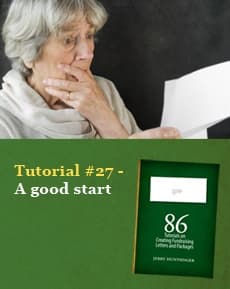Tutorial 27: A good start
You sit down and start to write. (I forgot to put out the cat. Joe is calling with a quote on that brochure. Will the new boss give me a raise?)
- Written by
- Jerry Huntsinger
- Added
- February 02, 2019

As you start putting words on paper, the distractions gradually fade away and are replaced by emotions. A tiny emotion creeps into a paragraph. You begin to concentrate at a deeper level, emotions are no longer held back. Finally, by the middle of the second page you are really into it.
You finish the letter, edit it and feel good because it worked up to a strong ending.
But what about those opening paragraphs? You edit the letter the next day and come to the emotional stuff on page two and think, ‘This is good’.
But you’ve got to learn to edit the letter and begin with that great emotion that didn’t surface until page two: chop, chop, chop. Do this a few times and you will start to catch on.
How do the pros get a letter off to a good start?
A successful experienced writer usually comes up with a strong, emotionally charged headline before any commitment to the writing of the copy. This approach often separates strong writers from weak writers.
Let me tell you why this is so important by playing a little game that I call ‘sudden death’.
If your letter arrives in the mailbox with a first class stamp, a personalised address and personalised letter – you have about 10 seconds to live: 1, 2, 3 , 4, 5, 6, 7, 8, 9, 10.
You’re lucky, because the personalisation gives the reader the motivation to get hooked into eye contact with the top of the letter. But if the opening paragraph is awesome in length or awesome in its level of boredom, the 10 seconds run out before the reader gets involved in the copy.
You’re dead.
If your letter comes in a carrier envelope with teaser copy and nonprofitpostage – you have only five seconds and you’re dead: 1, 2, 3, 4, 5.
One of three things must happen here:
- The teaser copy must intrigue the reader.
- The design of the package must encourage the reader to look inside.
- The reader must have previous positive experiences with letters from the organisation, this conditioned reflex gets the envelope opened.
Then, inside, you have about three seconds to live: 1, 2, 3. If the eyes of the reader have not come to a stop at some visual graphic, you’re dead.
A little frightening, isn’t it?
Readership studies and eye movement studies show that most readers go through a scanning process that involves the eyes finding a visual point of reference.
Then, instead of reading the letter word for word, the eyes will scan through the letter and the person will often sit there, turn the letter over and go through the material until coming to the end of the letter and the PS.
After this tremendously rapid scanning process, the reader then may go back to the opening headline or paragraphs and start reading word for word. If this occurs, you are a winner, your letter is going to be successful.
Many readers, once they achieve visual contact, have a compulsive need to read every word. However, even after they get started, if you force them to plough through seven-line paragraphs with no indentation their compulsion may rapidly wane.
For myself, I never begin a letter unless I’m completely satisfied with the headline or the lead sentence. Sometimes I get lucky and the right words appear in the sky and I write them down quickly before clouds obscure the vision.
But most of the time, I struggle and agonise. I try to work through creative blocks and turn the material over and over in my mind.
Then when I do have a headline or a lead sentence, I let it cool off for a few hours or a day and come back to it with a fresh look. If it’s still good stuff, I move ahead. If it’s not, I go outside and prune the roses.
When I’m working with another writer, I always ask that writer to come up with a headline, lead sentence and rough outline of the letter before any actual writing takes place. This can save hours and agony by preventing the writer from getting off to a false start.
To illustrate what I mean, here are a few paragraphs of a letter that begins with nice sounding words. But, hey, the donor had a long, hard day and really isn’t in the mood to deal with heavy philosophy and rational motivation.
Where does this letter really begin? Obviously, at the fifth paragraph; the first four paragraphs are a product of the writer’s emotional warm-up drill. They actually block the letter from achieving its goal.
Modern medicine treats the disease, but who treats the child?
Dear friend
Children shouldn’t have to face the devastation of cancer and death. But they do.
Each year, hundreds of kids are diagnosed with leukaemia and other forms of childhood cancer. While modern medicine often holds the disease in check, the specter of cancer hangs heavily over frightened children and concerned families.
But you can do something about it.
Courage Center, in cooperation with local hospitals, has developed special programs for kids with cancer and their families. Families like the Daberkows from Lakefield …
Lance Daberkow was diagnosed with leukaemia two days before Christmas in 2004. He was two years old. ‘Lance was so sick that they flew us to the Twin Cities for immediate treatment,’ his mother June said. ‘His platelets were so low that his teeth bled through the night.’
‘When they told me that he had cancer, I didn’t believe them. It took until New Year’s Eve for me to accept it. I can remember that night because there were fireworks going off over the river and everyone was celebrating. I sat on Lance’s bed in isolation and cried all night long.’
Although Lance’s prognosis was good, treatment required Lance and his mother to spend three months away from home in the hospital. While in the hospital, Lance’s sister Kelli and …
© SOFII Foundation 2010-2014.

















